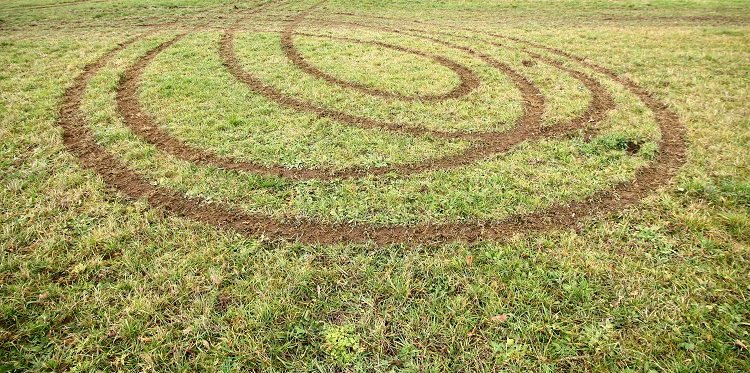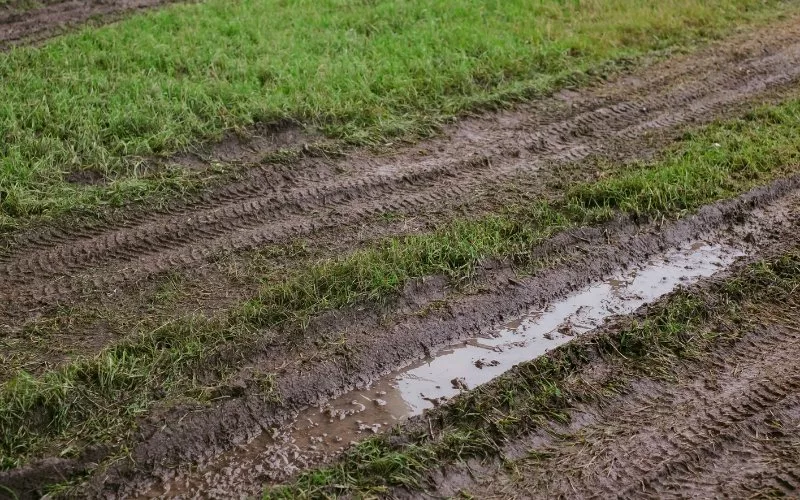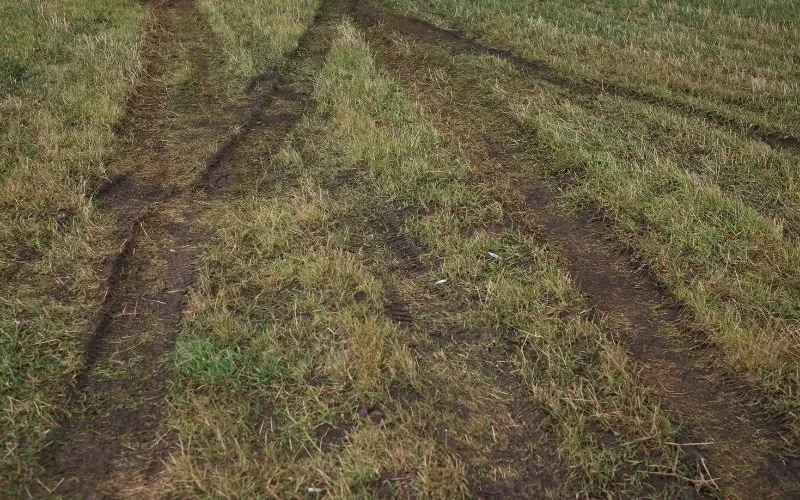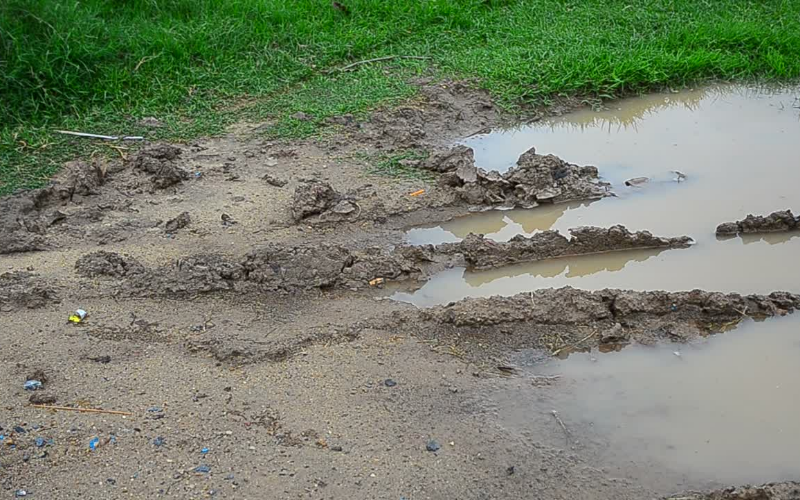There are a million reasons why you might find yourself with a tire track (or multiple if you’re unlucky) on your lawn.
It may be your fault (did you mow when it was wet?) or someone else may have done the damage (neighbor or delivery guy pull their vehicle onto it?).
But there certainly isn’t any point in crying over spilled milk. What’s done is done. The good news is that we’re here to talk you through how to fix tire ruts in your lawn.
We’ll go through the items you’ll need, when to do it and even give you some advice on how to avoid ever finding yourself in this situation again.

What You’ll Need
Before we explain the “how” let’s first outline what you’ll need to carry out this repair:
- Garden Spade
- Spade Fork
- Edger or Landscaping Knife
- Grass Seed
- Topsoil + Sand or Compost
- Garden Hose or Watering Can
When to Dig Out Your Tools and Make These Repairs
Thinking of heading out to the yard to get this done RIGHT NOW? Hold your horses!
When you complete this job is also important. The time of year when you repair these ruts and tire tracks can have a big impact upon the chances of the grass prospering afterward.
To have the absolute best chance of restoring your lawn’s beautiful appearance, you want to carry out this work when the grass is in what we call its “growth phase”.
The timing of this phase can vary depending on the grass type you have:
- Warm Season Grasses – Grasses in this category – Bermuda, Buffalo, Bahia, Saint Augustine, Centipede, and Zoysia are a few of the more common – have their strongest growth spurt towards the end of the spring period, before the hot summer weather arrives. This is the best time to fix those ruts.
- Cool Season Grasses – Kentucky Bluegrass, Perennial Ryegrass, Fine Fescue, and Tall Fescue are a few of the more common cool-season grasses, and have their strongest growth phase early-fall.
If your lawn is damaged during the winter period, it’s not a good idea to try and fix the ruts until the weather warms up, as most grasses grow extremely slowly during this cold period and won’t take a foothold.
Wait until spring at the earliest. If the damage occurs during summer, while not ideal, you can treat the area at this time of the year.
How to Fix Tire Ruts in Your Lawn

Now you know what you need and when to do this job, let’s talk about how to fix ruts in a lawn.
We’re going to put these ruts into two different categories, as what you’ll need to do will differ depending on which type of ruts you have on your lawn.
- Shallow Ruts (less than 4 inches)
- Deeper Ruts (more than 4 inches)
Shallow Ruts
Most of the time shallow ruts are fairly simple to fix. Here’s how to do it:
- Take your spade fork and use it carefully to loosen the compacted layer of soil. No need to go too deep with your fork here, as there’s only a thin layer of soil that is actually compacted.
- Now find the edge of the rut with your fork, place it at a 45-degree angle, push it a little way into the soil and then push down on the handle.
- You should find that the earth and sod “raise” by using the fork to pry it up in this way. Continue until it’s an inch or so above the level of the rest of your lawn, as when it “settles” it’ll be at the correct level.
Deep Ruts
If a heavy vehicle went over your lawn, particularly if it was wet, and you’re faced with the issue of fixing deeper ruts, the process is slightly more involved, but it’s definitely still possible to return the lawn to its former glory.
Follow these steps:
- Loosen the compacted ground first (this will make step 2 easier). Do this by placing the fork at a 45-degree angle along the edge of the rut again, but this time push the fork into the ground a bit more to loosen the compacted soil.
- Now you’ll need to get any grass that you can salvage out of the way so you can fill the rut in more easily. You can do this by taking either an edger or a landscaping knife and cutting down one side and each end of the rut. Make sure you cut through the thatch into the soil. Then use your fork to prize the grass up and fold it over onto the lawn. Now you’re ready to fill the rut in.
- Now the grass is out of the way, loosen up the soil in the rut some more, as that’ll give the new grass the best chance of taking root and flourishing.
- Grab your topsoil and some sand (or compost), and create a 50/50 mixture. The reason you do this is so the area will drain well and will be more resistant to compacting in the future.
- Fill in the rut with this mixture, making sure to not leave any gaps, and then fold the grass back down onto the freshly laid bed of soil, and press it down firmly so that the grass roots are in contact with the soil underneath (important). Ideally, once you’ve done this, the grass should sit just a little higher than the surrounding lawn. Once the ground settles, it’ll be level.
- More often than not you will need to seed the area too. Make sure to use the same variety of grass seed, and it can help to very carefully go over the area with a rake to ensure the seed is spread evenly. The most important thing to do after this is to water the area regularly to give the grass the best chance of taking root and flourishing.
And that’s really all there is to it. You’ll need to keep an eye on this area for a while to make sure it doesn’t sink below the rest of the lawn.
If it does, you may need to follow the steps we’ve outlined for shallow ruts above to bring it back level.
Or in the worst-case scenario, you may need to cut the sod up again and add some more of the soil moisture.
More Reasons to Fix Ruts When They Appear

Apart from the fact that a lawn full of tire tracks and ruts looks absolutely terrible, there are a number of other reasons to take action and fix them sooner rather than later.
Such as…
- Water Pooling – During periods of intense rain, the water will inevitably start to pool in these ruts, and because the soil at their base is compacted, it’ll have a hard time draining away too.
- Grass Won’t Grow – Just look at the state those tire tracks have left your grass in. You really think it’s going to grow back? You could try seeding it in this state, but likely only a fraction will actually take root and grow.
- The Peskiest Pests – Want more mosquitos around your yard? Stupid question. If you know anything about these critters, you’ll know that having pools of standing water around your property is not They’re breeding grounds for mosquitos!
How Do You Prevent Ruts in the First Place?
This article is obviously about how to fix ruts in a lawn, but the best thing would be to prevent them from ever happening in the first place!
Here are a few tips:
- Don’t Mow When Wet – One of the most surefire ways to create a nasty looking rut on your lawn is to either mow the lawn when it’s wet, or to drag other types of heavy machinery over it when it’s wet. The weight will cause these items to sink into the ground and create nasty marks all over the place. Don’t do it – wait until it’s dry!
- Different Day, Same Pattern – Think about how you mow your lawn for a second. Do you always tend to follow the exact same route around your lawn? If so, you’re compacting the soil on each mow and it won’t have time to recover in between cuts. Instead, switch it up. There are many lawn mowing patterns. Go at your lawn from a different way each time, as this will give the ground that all-important recovery time and make sure fixing ruts is never on your “to-do” list again.
- Aggressive Tire Tread – If you’re going to be tackling tricky hills with a ride-on mower, you may need a tire with a more aggressive tread that offers extra traction, but otherwise you likely won’t. The only thing they’ll do is cut through your turf and leave you wondering how to fix tire tracks in the lawn.
It’s also worth looking into how to protect your lawn from cars and other vehicles. There’s actually quite a lot you can do to minimize the risk of others creating a load of work for you!
And as they say, prevention is always better than the cure.



Thank you
I’ve had a contract unknownly cause this problem on a empty lot next to my home
So I wanted to fix it myself
We had a company install a new lawn sprinkler system in our yard this past Fall. They tore up our lawn, but didn’t fix it. There are vehicle tracks everywhere on our lawn that used to be beautiful and flat. Also there are uneven areas all over the yard due to their hastiness in covering up the areas that were dug. It looks destroyed. This is too much for my husband and I to fix. What kind of lawn companies can we contact to hire to fix this? We don’t want this company to fix this since they said our lawn looked “fine”. We haven’t paid them the full amount yet because at my insistence they said they would come back to “fix” it. However, I want to hire a company we can trust will do a good job, and deduct this cost from the amount we will pay the irrigation company.
We live in zip code 49546. We have no idea how to find a company to fix this properly. Thank you.
Hi Lonna. I am sorry to hear that this happened to you. I’ve dealt with companies that have left ruts and other damage after “finishing” a job as well. Never a good experience. If you have already communicated to them that you are unsatisfied with the work and they said it looks “fine” I would do two things in order to find someone else to work on the project.
First, I always recommend talking to your neighbors, if possible. The Nextdoor app (nextdoor.com) is a great place for this in most areas. A post with a comment like this, explaining what happened or what you’re looking for should get you some good local recommendations for people that have done a good job for others in your local area.
Second, making a post on a site like Angi.com (Angie’s List) can help you connect directly with local contractors or have them “come to you”. If you go this route, always get a quote in writing that specifies exactly what’s supposed to be done, including cleanup, before the work begins.
If neither of these options work out, you can try calling any local, small garden centers to see if they have any recommended contractors. Local arboretums or public gardens sometimes contract out landscaping work as well and may know someone to hire. One of the best landscapers I have worked with was someone I saw working on the median in front of a local restaurant and asked for their card. Similarly, if you see good work done around a small business or somewhere where the manager might be easy to get ahold of, it never hurts to ask who was responsible for it.
I hope this helps. Tom 🙂